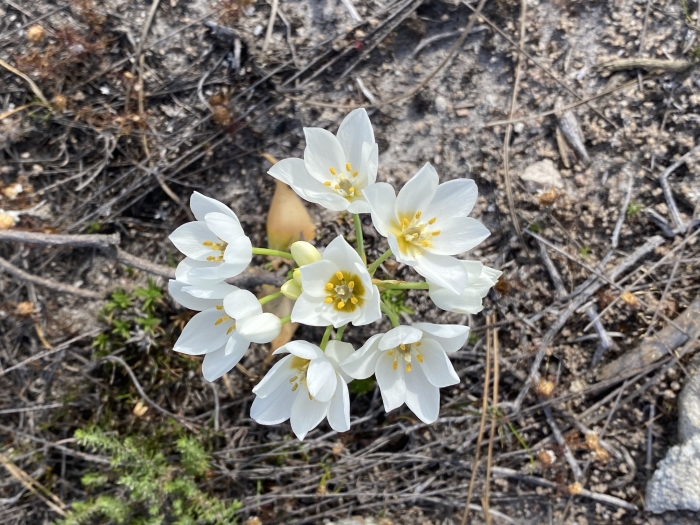Wonder Flower
(Ornithogalum thyrsoides)
Wonder Flower (Ornithogalum thyrsoides)
/
/

Dave U
CC BY 4.0
Image By:
Dave U
Recorded By:
Copyright:
CC BY 4.0
Copyright Notice:
Photo by: Dave U | License Type: CC BY 4.0 | License URL: http://creativecommons.org/licenses/by/4.0/ | Rights Holder: Dave U | Publisher: iNaturalist | Date Created: 2020-10-27T14:20:42Z |





















































Estimated Native Range
Summary
Ornithogalum thyrsoides, commonly known as Wonder Flower, is a deciduous perennial herb native to the sandy coastal plains and inland areas of the Western Cape and Eastern Cape provinces in South Africa. This bulbous plant typically reaches 29–50 cm (11–20 in) in height and becomes dormant during the winter months. It features a rosette of fleshy leaves that wither after the flowering period. The Wonder Flower produces a dense raceme of 30-50 or a more open corymb of 5-20 star-shaped flowers. Each flower is bowl-shaped, supported by green bracts that are roughly the same length as the pedicels. The blooms are initially white to creamy-white with brown or green centers that fade as the flowers age. They are particularly noted for being phototropic, meaning they turn towards the sun. Flowering occurs from October to February, providing a long-lasting display that is highly valued in cut flower arrangements.
The Wonder Flower is appreciated for its striking, long-lasting blooms and is often used in rock gardens, borders, and as a container plant. It thrives in sunny to partially shaded locations with shelter from strong winds. The plant requires well-drained soil and moderate watering, with a dry period during dormancy to prevent bulb rot. It is relatively low-maintenance, but gardeners should be cautious of its potential to become invasive outside its native range. After flowering, the plant enters a period of dormancy; during this time, the bulbs should be protected from freezing temperatures to ensure their survival.CC BY-SA 4.0
The Wonder Flower is appreciated for its striking, long-lasting blooms and is often used in rock gardens, borders, and as a container plant. It thrives in sunny to partially shaded locations with shelter from strong winds. The plant requires well-drained soil and moderate watering, with a dry period during dormancy to prevent bulb rot. It is relatively low-maintenance, but gardeners should be cautious of its potential to become invasive outside its native range. After flowering, the plant enters a period of dormancy; during this time, the bulbs should be protected from freezing temperatures to ensure their survival.CC BY-SA 4.0
Plant Description
- Plant Type: Herb
- Height: 1-2 feet
- Width: 0.15-0.3 feet
- Growth Rate: Moderate
- Flower Color: White, Green
- Flowering Season: Spring, Winter
- Leaf Retention: Deciduous
Growth Requirements
- Sun: Full Sun, Part Shade
- Water: Low
- Drainage: Medium
Common Uses
Bee Garden, Butterfly Garden, Fragrant, Low Maintenance, Potted Plant, Showy Flowers
Natural Habitat
Sandy coastal plains and inland areas of the Western Cape and Eastern Cape provinces in South Africa
Other Names
Common Names: Star-Of-Bethlehem, Christmas-Lily, Chinkerinchee, Rock-Lily, Wonder-Flower, Chincherinchee, Port Lincoln-Lily, Cape-Lily, Star-Of-Bethlehem, Kapstjärna
Scientific Names: , Ornithogalum thyrsoides, Ornithogalum gilgianum, Eliokarmos ceresianus, Eliokarmos thyrsoides, Ornithogalum ceresianum, Ornithogalum conicum, Ornithogalum coarctatum, Eliokarmos coarctatum, Lomaresis alba
GBIF Accepted Name: Ornithogalum thyrsoides Jacq.